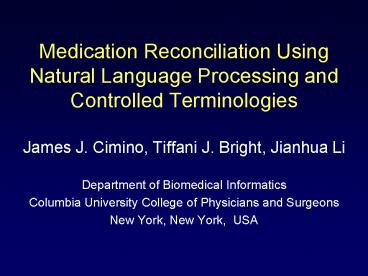Medication Reconciliation Using Natural Language Processing and Controlled Terminologies PowerPoint PPT Presentation
Title: Medication Reconciliation Using Natural Language Processing and Controlled Terminologies
1
Medication Reconciliation Using Natural Language
Processing and Controlled Terminologies
- James J. Cimino, Tiffani J. Bright, Jianhua Li
- Department of Biomedical Informatics
- Columbia University College of Physicians and
Surgeons - New York, New York, USA
2
The Challenge of Medication Reconciliation
3
Many a Slip Twixt the Cup and the Lip
Patient is Supposed to Take Patient is not Supposed to Take
Patient is Taking Reports Taking Doesnt Report Taking Reports Taking Doesnt Report Taking
Patient is not Taking Reports Taking Doesnt Report Taking Reports Taking Doesnt Report Taking
4
Problems and Solutions
- Errors due to
- Not starting medications the patient should be
taking - Starting medications the patient shouldnt be
taking - Not communication starts/stops to next caregiver
- Not communicating changes to patients
- Beers, et al. J Am Geriatric Society 1990
- 83 of hospital admission histories missed one or
more medications - 46 missed three or more
- Problems occur at all transitions in care
- Continue all outpatient medications
5
Electronic Health Records to the Rescue!
Go
Stop
Stop
Go
Stop
Stop
Stop
Go
Stop
?
6
Computer Assisted Medication Reconciliation
- Poon et al. JAMIA 2006
- Preadmission Medication List
- Grouped medications by generic names
- Text sources
- Mutiple sources
- Substitutions might occur
- Confusing chronology
- Information overload!
7
Our Approach to Medication Reconciliation
- Multiple inpatient and outpatient systems
- Natural language processing to get codes
- Medical knowledge base to group codes
- Chronological presentation
8
Methods
- All recent admissions for one physician (JJC)
- Multiple inpatient and outpatient resources
- Carol Friedmans Medical Language Extraction and
Encoding (MedLEE) - US National Library of Medicines Unified Medical
Language System (UMLS) - Columbias Medical Entities Dictionary (MED)
- American Hospital Formulary Service (AHFS)
classification - Evaluation of ability to capture, code and
organize
9
Data Sources
1. Prior Clinic Note
2. Prior Outpatient Medications
3. Admission Note
4. Admission Note Plan
5. Admission Orders
6. Admission Pharmacy Orders
7. Active Orders at Discharge
8. Discharge Pharmacy Orders
9. Discharge Instructions
10. Discharge Plan
11. Clinic Note after Discharge
12. Outpatient Medications after Discharge
Data Source System Data Type
Narrative
Coded
Narrative
Narrative
Coded
Coded
Coded
Coded
Narrative
Narrative
Narrative
Coded
WebCIS
WebCIS
WebCIS
WebCIS
Eclipsys
WebCIS
Eclipsys
WebCIS
Eclipsys
WebCIS
WebCIS
WebCIS
10
Results
- 70 patient records reviewed
- 30 hospitalizations identified
- 17 met inclusion criteria
- MedLEE found 623/653 (95.4) medications
- Total of 1533 medications (444 unique) in MED
11
Medications by Source
Data Source Meds Records with Data Meds per Patient
Prior Clinic Note 157 17 9.2
Prior Outpatient Medications 211 13 16.2
Admission Note 102 14 7.3
Admission Note Plan 41 12 3.4
Admission Orders 88 8 11.0
Admission Pharmacy Orders 152 14 10.9
Active Orders at Discharge 93 8 11.6
Discharge Pharmacy Orders 171 14 12.2
Discharge Instructions 60 7 8.6
Discharge Plan 123 16 7.7
Clinic Note After Discharge 140 16 8.8
Outpatient Medications after Discharge 225 13 17.3
Narrative text
12
MedLEE Terms Found
MED Terms
13
Transition from Outpatient to Inpatient
Patient 9 201204 Anticoag- ulants 240400 Cardiac Drugs 240800 Hypoten- sive Agents 280000 CNS Agents 281604 Antidep- ressants
Prior Clinic Note coumadin verapamil cozaar cymbalta
Prior Outpatient Medications Coumadin 5 mg Tab Verapamil 180 mg Extended Release Tablet Losartan Potassium 100 mg Tablet Pregabalin 50mg Capsule
Admission Note coumadin verapamil cozaar cymbalta
Admission Note Plan coumadin
Admission Orders Warfarin Sodium Oral 10 MG Verapamil SR Oral 240 MG Losartan Oral 50 MG
Admission Pharmacy Orders WARFARIN TAB 5 MG 10 MILLIGRAM VERAPAMIL SR TAB 240 MG LOSARTAN POTAS-SIUM TAB 50 MG
14
Transition from Outpatient to Inpatient
Patient 9 201204 Anticoag- ulants 240400 Cardiac Drugs 240800 Hypoten- sive Agents 280000 CNS Agents 281604 Antidep- ressants
Admission Pharmacy Orders WARFARIN TAB 5 MG 10 MILLIGRAM VERAPAMIL SR TAB 240 MG LOSARTAN POTASSIUM TAB 50 MG
Active Orders at Discharge Verapamil SR Oral 240 MG Losartan Oral 50 MG
Discharge Pharmacy Orders VERAPAMIL SR TAB 240 MG LOSARTAN POTASSIUM TAB 50 MG DULOXET- INE CAP 20 MG
Discharge Instructions cymbalta
Discharge Plan cymbalta
Clinic Note After Discharge coumadin verapamil cymbalta
Outpatient Medications after Discharge Coumadin 5 mg Tab Verapamil 180 mg Exte- nded Release Tab Losartan Potassium 100 mg Tablet Pregabalin 50mg Capsule
15
Discussion
- Data from multiple coded and narrative sources
can be coded automatically and merged into a
single form - The UMLS and MED are both needed for coding to a
single terminology (AHFS) - Further work on MedLEE and the MED are needed
- Drugs tend to group into one per class allows
for change from one generic to another - Chronology by drug class can highlight changes in
medication plans - Changes can be intended or unintended, but should
not be ignored - The next step is medication reconciliation
16
(No Transcript)
17
(No Transcript)
18
(No Transcript)
19
(No Transcript)
20
(No Transcript)
21
(No Transcript)
22
(No Transcript)
23
(No Transcript)
24
(No Transcript)
25
Conclusions
- Diverse medication data can be automatically
integrated - Organizing data by time and drug class can
highlight possible errors

